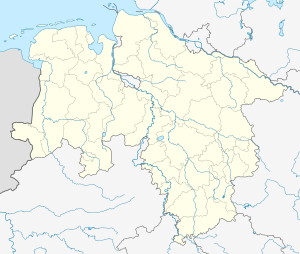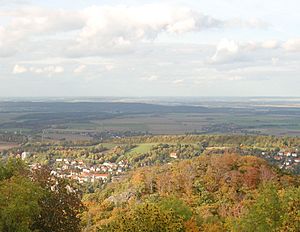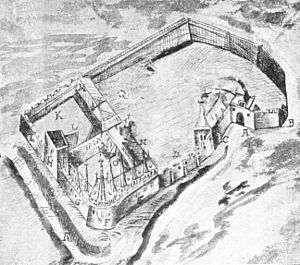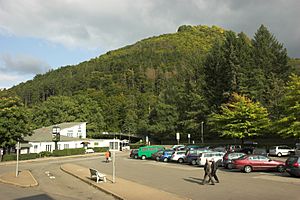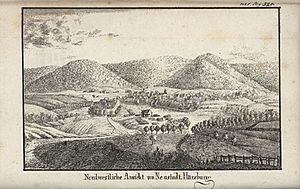Harzburg facts for kids
Quick facts for kids Harzburg |
|
|---|---|
| Große Harzburg | |
| Bad Harzburg, Lower Saxony | |
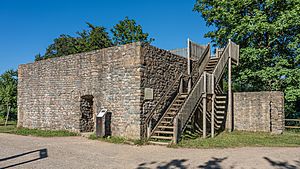
Reconstruction of foundation walls of a tower
|
|
| Coordinates | 51°52′17″N 10°34′03″E / 51.87139°N 10.5675°E |
| Type | Hilltop castle |
| Code | DE-NI |
| Height | 482 m above sea level (NN) |
| Site information | |
| Condition | Wall remnants, ditch |
| Site history | |
| Built | 1065 to 1068 |
| Garrison information | |
| Occupants | King, emperor |
The Harzburg, also known as Große Harzburg (which means "Great Harz Castle"), was once an important imperial castle. It sits on the edge of the Harz mountains, looking over the town of Bad Harzburg in Lower Saxony, Germany.
King Henry IV had it built between 1065 and 1068. It was partly destroyed during the Saxon Rebellion in 1073-75. About a century later, it was rebuilt by Emperor Frederick Barbarossa and then by Otto IV, who passed away there in 1218.
Over time, the castle fell into ruin. Today, only parts of its old walls, towers, and the castle well remain.
Contents
What's in a Name?
The castle was first called Hartesburg in 1071. Its name comes from the Harz mountain range. In old German, "Hart" meant "mountain forest." So, "Harzburg" simply means "Harz Castle."
Where is the Harzburg?
The Harzburg ruins are located high above the town of Bad Harzburg. They sit on top of the Großer Burgberg hill, which is about 483 meters (1,585 feet) high.
You can reach the top using the Burgberg Cable Car. From there, you get amazing views! You can see the northern Harz Foreland and even far into the North German Plain. Looking south, you can see the thick forests of the Harz National Park and the Brocken mountain.
The old castle walls are open for everyone to visit. Information boards explain what the castle looked like and what parts are left. The castle had two main towers called bergfrieds. One of them, a square tower, has been partly rebuilt.
An interesting feature is a wide moat carved out of the rock. This moat splits the castle into two parts, east and west. A modern stone bridge now connects them. The castle's well got its water from a nearby spring called Sachsenbrunnen. In medieval times, water traveled hundreds of meters through wooden pipes.
On the northern side of the castle area, there is a 19-meter (62-foot) tall Canossa Column. It was put up in 1877 to honor Chancellor Otto von Bismarck. It also marks 800 years since King Henry IV's famous Walk to Canossa.
The castle grounds also have an old Bismarck Elm tree and a memorial hall. You can also see a modern statue of a god called Krodo and a restaurant.
Nearby, on the Kleiner Burgberg hill, are the remains of the "Little Harz Castle." To the east, on Sachsenberg, you can see traces of a rampart. This might have been built by the Saxons when they tried to attack the Harzburg.
History of the Harzburg
Long ago, in the 10th century, King Henry the Fowler made a peace deal with Hungarian invaders near Werla Castle. Later, in the 11th century, Emperor Henry III loved to stay at the Imperial Palace of Goslar.
However, Henry III was not popular with the local Saxon nobles. He was from a different region, and his court was very expensive. After Henry III died in 1056, his son, King Henry IV, became king in 1065. He soon started conflicts with the Saxons over land in the Harz mountains.
King Henry IV and the Castle
While Henry IV was young, the Saxon nobles became very powerful. One noble, Otto of Nordheim, even took part in a plot to take the young king in 1062.
Because of these tensions, the Harzburg was built between 1065 and 1068. King Henry wanted to show his power in Saxony. The castle was built in a smart location to protect the Goslar imperial palace and the Rammelsberg mines. Its walls were very strong, making the castle almost impossible to capture at the time.
The Harzburg was not just a strong fortress; it was also a grand palace. It had a very large hall and a church. Henry even moved many holy items to the church. He also built a family tomb there for his brother and son, who both died young.
In 1073, the Saxon Rebellion began. Nobles marched against King Henry, who was in Goslar. Henry had to escape to the Harzburg with his royal treasures. The Saxon forces, led by Otto of Nordheim, were huge, with about 60,000 men. Henry's castle only had 300 defenders.
The king eventually fled to another region in August. Legend says he escaped through the castle's well and a secret passage.
In 1074, Henry was forced to agree to destroy his castles, including the Harzburg. He only took down the walls and towers, leaving the main buildings. But angry peasants later completely destroyed the castle. They even damaged the church and the royal family tomb. This made Henry very angry, and he attacked the Saxons again. On June 9, 1075, he defeated them in battle.
Henry IV never returned to the Harzburg. The Pope even put a ban on the ruined site. In 1077, Henry had to make a famous journey, the Walk to Canossa, to get the Pope to forgive him.
Hohenstaufens and Welfs
Later, during a conflict between Emperor Frederick I (from the Hohenstaufen family) and Duke Henry the Lion (from the Welf family), the castle was rebuilt. This work continued until 1180. Frederick needed to protect Goslar from Henry's forces.
The castle was finished by Henry the Lion's son, Emperor Otto IV. He became the sole King of the Romans in 1208. The Pope crowned him Holy Roman Emperor the next year. However, they soon had a disagreement. Otto was defeated in battle in 1214 and went back to his home in Saxony. He died at the Harzburg on May 19, 1218.
After Otto IV's death, the Harzburg lost its main role as an imperial castle. In 1269, it was given to the Counts of Wernigerode.
Later Years
Over the next few centuries, the castle changed owners many times. Around 1370, it was taken by Duke Otto of Brunswick-Göttingen. He gave it to Hans von Schwicheldt. But Hans von Schwicheldt's sons later turned it into a "robber baron" castle. They attacked and robbed the surrounding lands.
The castle became less and less important and slowly fell apart. It was too expensive to rebuild in the 16th century. During the Thirty Years' War, the castle changed hands a few times. But by then, this type of fortress was no longer useful in warfare.
In 1650, people started tearing down the remaining parts of the ruin. Since then, only the foundation ruins and the well are left. The town at the foot of the hill, originally called Neustadt, took the castle's name in 1892 and became Bad Harzburg.
Images for kids


